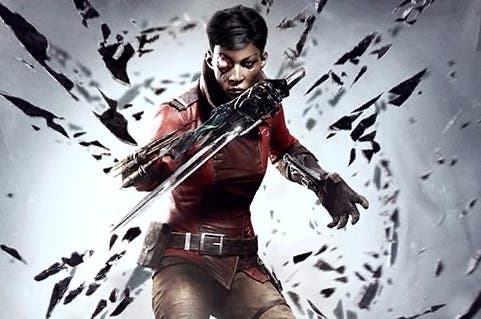Dishonored: Death of the Outsider review
God bothering.
Deicide is one of gaming's more popular pastimes - not quite as popular as smashing pots for herbs but easily on par with say, fishing or amateur photography. Pretty much every JRPG worth its salt concludes with the party nobbling either a vengeful god or somebody who's on the verge of becoming one. Kratos can't get through brunch without beating some Olympian cousin to death with the waffle iron, and Bayonetta signs off by kicking the Creator squarely into the sun. Death of the Outsider is one of the subtler variations on the theme: Dishonored's take on divinity is, after all, more embroiled in the role divinity actually plays in society, a question of psychic archetypes and community bonding rituals, rather than multi-stage health bars and the ability to squirt thunder from your pinkie. To murder the Outsider, representative of the Void that yawns beneath the surface of Dishonored's tortured steampunk universe, isn't just to leave this realm without a king - it's to alter the very structure of the game's reality irrevocably, to the point of throwing the prospect of a threequel into enormous doubt.
It takes a certain sort of person to cut down a god. Voiced with steely menace by Rosario Dawson, Billie Lurk is just the right fit. She's been there from the beginning, an accomplice to regicide in the first game and its expansion, a reclusive and guilt-tormented onlooker in the second, and as Death of the Outsider opens, it's clear that she's had quite enough. Where Emily Kaldwin was a sophomore in both the art of assassination and the ethical quandaries of using violence to correct violence, Billie has slit hundreds of throats and been through the whole moral-choice dog-and-pony show multiple times over. Having plunged one city into darkness and helped salvage another, she's less bothered about who, in particular, is screwing over who and more with the underlying mythos that abets Dishonored's cycle of downfall and insurrection, of tyrants overthrowing tyrants. Even before a reunification with old mentor Daud, star of the Knife of Dunwall, sets her on the Outsider's trail, she comes across as a woman ready to leave this world behind. "It's quiet out here," Billie muses during the intro to the fifth and final mission. "Nothing but me and my thoughts." The Outsider, too, seems ready to wash his hands of the whole enterprise, appearing in visions before each mission to offer desultory commentary and suggest that, just possibly, killing him isn't the only way to bring this tale to a close.
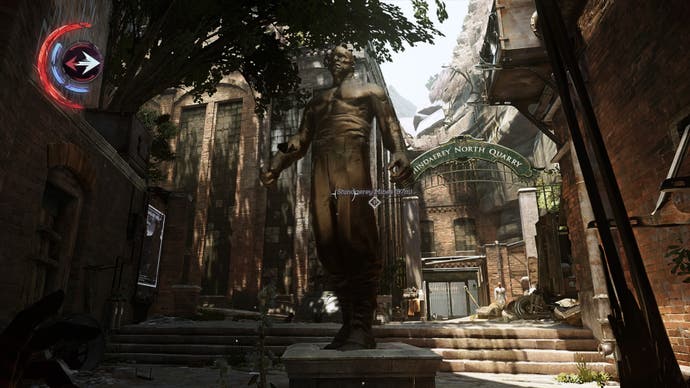
From Billie's ruthless detachment as much as the expansion's smaller scope proceeds the decision to retire Dishonored's old Chaos/Order system, whereby wreaking havoc in each chapter would degrade the ambience and alter the challenge in subsequent areas. The consequence of the system's absence is, firstly, that you feel more free to let rip with Billie's arsenal of murderous traps, projectiles and sorcerous abilities - there's no longer a persistent world state to worry about, though in-game newspaper articles do keep track of your antics from level to level. Some of the secondary objectives you can accept from black market notice boards actively nudge you towards outright mayhem. There's the option of killing all but one enemy in the fourth mission to earn a special bonecharm, a task I undertook with relish, using the new hook mine to yank enemies into each other before immolating them with incendiary rounds from Billie's wristgun. But as you go on, the absence of Chaos/Order ultimately lends what decisions you do make about the fates of other characters more weight, because your interpretation arises purely from narrative context and detailing - from what NPCs write in diaries or letters, what they mutter when they think they're alone - rather than some over-arching, gamey contrivance.
Not being able to shape the scenery chops the replay value down a bit, but the equatorial alt-Victorian port of Karnaca remains a masterpiece of storied aesthetics and overlapping routes, worth dwelling on for much longer than the expansion's 10-15 hour playtime. Every nook and cranny is both an exquisite study in pomp or squalor and an infiltration opportunity of some sort. Poster-scabbed alleyways lead to buried trapdoors and sewer mouths. Dangling banners point the way up to balconies and perchable street lamps, while pipes snake invitingly around and into the masonry of fortified structures. There are dozens of lore documents to track down, and there are those secondary objectives (e.g. nicking a letter from a guard without raising the alarm) to spur exploration, but even without such trophies, you'll want to investigate every lit window, cellar or stairwell for the rancid luxuriance of the interior design - fat, creamy scrolls of peeling wallpaper, framed butterfly collections, torn and bloodied velvet upholstery, boilers and steam engines wheezing like cornered animals.
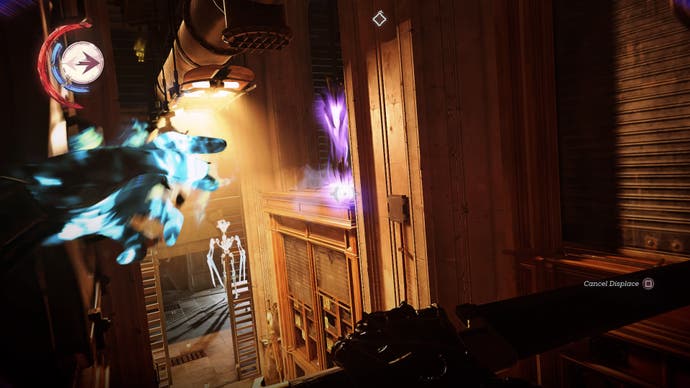
Getting into these spaces is as fun as uncovering what they harbour. Billie's moveset is another reworking of Corvo's from the original game, one that puts the emphasis a little more on stealth and planning than pyrotechnics. Her version of Corvo's legendary Blink dash, Displace, drops a destination marker rather than just teleporting you instantly. This slows down traversal a notch, but allows you to prepare an escape route before making your move on a position; in a brilliantly macabre touch, it also deposits a pile of purple fleshy shards in your wake, suggesting that you are, in fact, eviscerating yourself every time you Displace. Billie's recon ability is Foresight, the Dishonored equivalent of a Tom Clancy UAV, which freezes time and lets you fly around the level within a certain range, mark people or objects on the HUD, travel through vents and plant a Displace marker somewhere you can't otherwise reach.
This proves a bit rickety in practice - you can only rise to a certain height using the ability relative to the terrain, so if you cruise off a ledge you'll plummet, and it's slightly annoying that you can't tag enemies by other means - but Foresight lends itself to some exhilarating combos, like placing a marker inside a barred office so you can warp behind a clerk without booting down the door. More exhilarating still is Semblance, Death of the Outsider's take on Hitman's social stealth system, which lets you pose as an NPC after knocking them unconscious, sucking the poor soul's face into the palm of your hand. The ability only drains Void energy when you move, so it's possible to halt and take stock (or lighten a few pockets) while strolling amongst unaware enemies. You can also deploy Semblance on a second target while in disguise, leaping from body to body like some tropical disease.
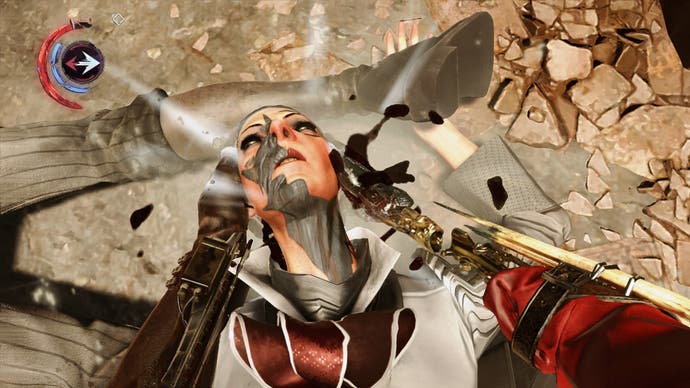
Dishonored's Void energy and role-playing subsystems have been cleverly overhauled. Energy now replenishes automatically after a few seconds, so top-up elixirs are no longer necessary - this means you'll spend less time foraging for resources, but still requires you to use your powers efficiently. There's no longer a fixed upgrade system - you're handed all three abilities after the game's intro mission, with a telekinetic force attack becoming available during the third. Instead, you'll tailor your approach using bone charms, most of them discovered in the world, which serve as either ingenious ability mods or simple stat buffs. You could spec for a lower profile, with charms that render you briefly invisible after Displacing and impair the eyesight of any guards you've marked with Foresight. You could equip a charm that lets you place a second Displace marker, in order to knife two opponents on either side of a room in swift succession, or you could boost your survivability with a charm that restores health when you land a blow.
In terms of the specific scenarios you'll apply these methods to, there's nothing in Death of the Outsider that's quite up there with Dishonored 2's terrific Clockwork Mansion, but the third mission's bank heist is a marvel, offering a choice of three opening access routes, a brush with a new model of Jindosh's Clockwork Soldier, and a mouth-watering collection of ways to use the bank's own security and PA systems against it. The fourth mission, meanwhile, is memorable for how it restructures one of the second game's levels, blocking off certain routes while exposing others and introducing different foes. If you're new to Dishonored, Death of the Outsider isn't a bad point of entry - there are video tutorials for each move, and the plot doesn't rely on knowledge of the first two games - but you'll definitely squeeze more out of these locations if you're familiar with their histories.
There aren't that many fresh faces among the NPC cast, but I enjoyed reacquainting myself with the Brigmore Witches, that once-formidable cult of swaggering, militant feminists, and their supercilious puritan adversaries the Overseers. Some of the story's sadder moments come when you overhear former witches - now reduced to scrapping in underground boxing rinks or acting as private security for illicit bars - mourn their lost abilities and fallen sisters. By comparison, the actual plot ends rather abruptly and in a way that doesn't, for my money, do justice to our long association with the Outsider as players or what he represents in Arkane's misbegotten cosmos. The final mission itself has a lot of promise - it borrows a conceit from Dishonored 2's Crack in the Slab, with a layout you'll experience in two variations, and offers some enticing insights as to the nature of the Void, but it doesn't play these ideas out as elaborately as I'd have liked.
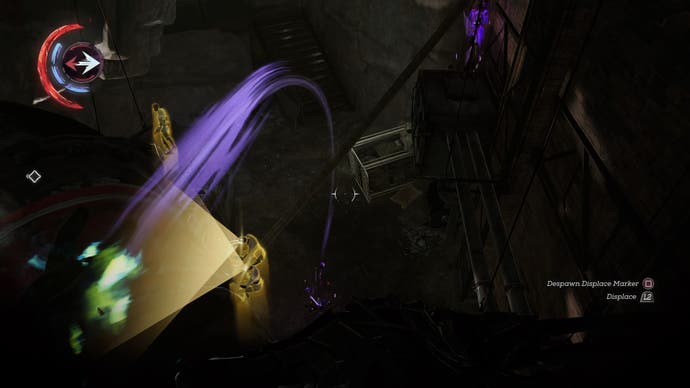
In general, Death of the Outsider occasionally feels like a Dishonored 3 that hasn't quite become flesh and perhaps, never will, going by sales of the second game and of Arkane's most recent immersive sim, Prey. The trading of fixed upgrades for the flexibility of bone charms, streamlined energy system and dialing-back of Chaos/Order seem a foundation worthy of a grander tale, one that tugs a little harder on some of the dangling threads here - Billie's ability to listen to rats, for example, a promising rewrite of the Heart of Dunwall narrative mechanic that never really goes anywhere, or the mournful profundities of Dishonored's whales, which are referenced but not dwelt upon in the final area. There have been far, far worse finales, though, and erasing the god whose mystical gifts create the framework for a game of this sort is quite the way to drop the curtain. If only every series could meet its end so boldly, not simply raging against the dying of the light but taking a knife to its own shadow.
